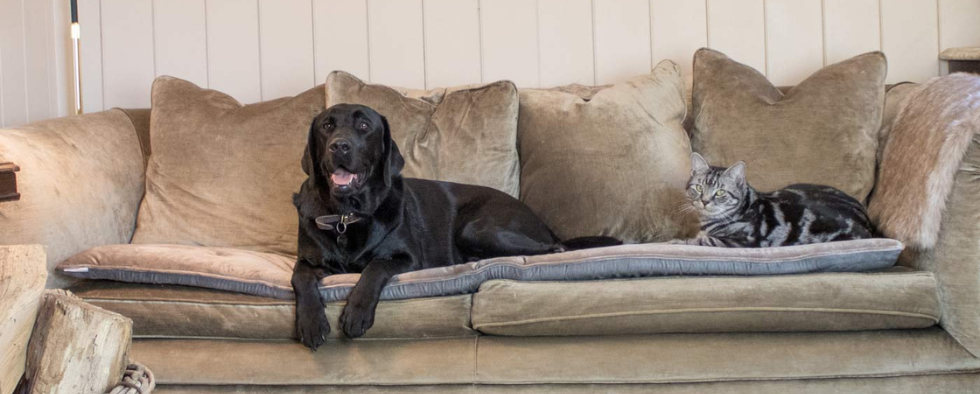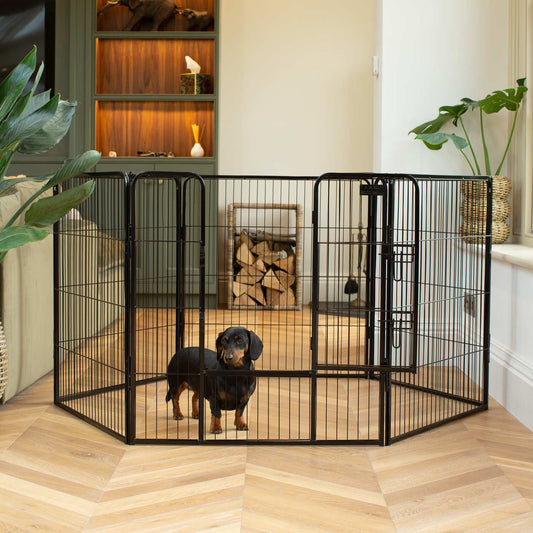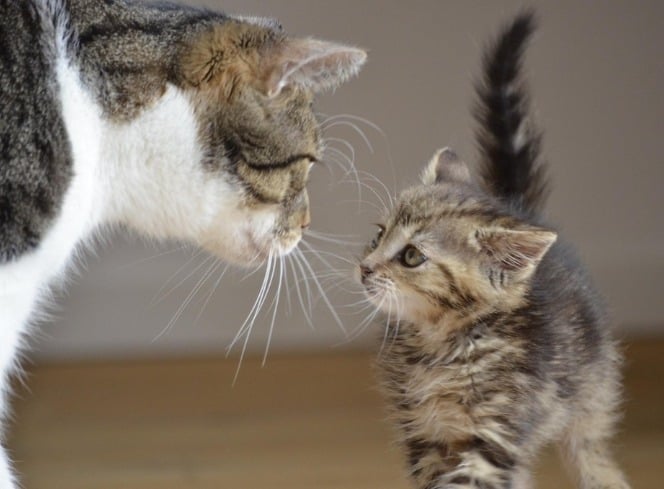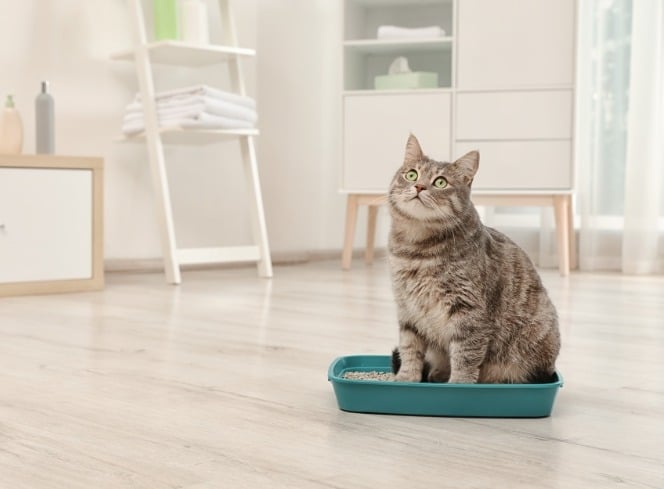People have stereotyped the relationship between cat and dog for an age; pitting them against one another as mortal foes. However the reality is somewhat different and many families enjoy both canine and feline company in the same home.
Do Cats And Dogs Get Along?
They defintely can get along, it's all down to their personalities and the way you as an owner both train them and manage their environment. The way you introduce them and manage that introduction period will help form the foundation for their relationship.
The important thing to take into consideration is the personality of the pets in question. Finding two animals whose personalities gel, rather than conflict, is key. If you have an older, more relaxed pet for example, they will probably find it difficult to adjust if introduced to a new kitten; if you have a boisterous dog who loves to play, then a nervous cat may not be the right choice for you.
If you are thinking about introducing a cat and dog into your home, or you already have them and need tips on how to help them get along, read our list of things we think you should consider.
Dog Breeds That Can Live With Cats
All dog breeds have the potential to get along with cats, that being said there are some breeds who typically have a personality which is more suited to living with a cat. These include breeds such as Golden Retrievers, Pugs and Basset Hounds. The experts at Purina have put together their list of top cat friendly dog breeds, which is definitely worth checking out if you're thinking about adding a dog to your cat household.
How To Introduce Your Dog and Cat to a New Puppy Or Kitten
1. Let Them Smell Each Other First
We use scent to settle our pets in many situations. Many people bring home a blanket with Mum’s scent on when they first bring kitten or puppy home to help settle the new arrival. Similarly, if you want to get two animals used to each other it’s a good idea to share each of their scents with the other before they actually meet. This could mean giving them each a blanket from the others bed for example. This way they will be somewhat familiar with one another already.
2. Ensure Your Cat Has Their Own Territory
Cats enjoy their own space regardless of whether they share the home with other pets or not. If you are thinking of introducing another pet, then make sure your cat has places to retreat to when they want some peace and alone time. Cats naturally love climbing, so providing them with a cat tree or platforms attached to the wall is ideal and will give them somewhere they can watch the others in the house from a distance.
Also, try to keep their food in a different location to the dogs and place their litter tray somewhere that they won’t be distracted by the dog. A quiet spot of their own is ideal so they can do their business in peace.
You can try sectioning areas off with dog gates. Just be wary of agile pups and those too large for a gate. This is ideal for young puppies though, whilst they are getting used to their feline friends.
3. Raise Them Together
If you have the chance, raise your cat and dog together from a young age. Puppies and kittens will learn to accept things much more quickly than older pets who are set in their ways. Dogs are not only less confident in their younger years, but also smaller and therefore less physically intimidating to a smaller cat. Introduced in this way, cats will more quickly assume their place at the top of the cat/dog social hierarchy!
4. Plan The First Time They Meet Carefully
It’s best to keep them in separate parts of the house for at least the first few days before you let them meet face-to-face. This will allow them both time to get to know the smell of the other and get to know their new homes.
As with humans, first impressions are important. Finding a common interest can help the process; mealtimes are enjoyed by all creatures great and small, so why not start with food?
One way to introduce them initially is to keep your cat and dog on either side of a door whilst you give them their food; they won’t see each other, but they will smell each other. This is a good way for them to associate the smell with something positive. If you can do this for a number of days whilst being able to keep them separate in the home, it will help in the long-run.
Keep your dog on a lead for extra control, just-in case he gets excitable. You could start with a door and then slowly introduce them to each other visually with a dog gate between. If you can stretch this process over time, it will help keep it gradual and give them both time to adjust.
During this process, alternate the rooms that each is allowed in thus giving them both more opportunity to get to know the smell of the other.
5. Make Sure Your Cat Is Relaxed
When you do introduce them face-to face for the first time ensure your cat is totally relaxed. Keep your cat in your arms (long sleeves are a good idea!) whilst someone else brings your dog into the room on a leash. Take it really slowly, keeping an eye on both their reactions. Gradually bring the dog closer one or two steps at a time and allow both to settle at each step. You could pop your cat in their carrier if that seems easier and more controlled. The last thing you want is for your cat to claw your arm in panic.
6. Show Equal Amounts Of Fuss To Both Pets
It’s important to show equal amounts of affection to both pets during the introduction phase. Pets are just as prone to jealousy as children, so show them both that they’re loved and all should be fine.
7. Separate Them After Their First Meeting
After they’ve first met, even if all went swimmingly, make sure to separate them again. Introducing them should be a gradual process with a number of these meetings taking place. Gradually lengthen the interactions over time and they will soon grow familiar with one another.
8. Let the Cat Loose First
Once they seem comfortable in each others company, try giving the cat freedom to roam whilst keeping your dog on a lead. You want your cat to feel as comfortable as possible - in most cases they will be the smallest of the two animals. After a few interactions like this, if your dog seems content, try letting them off the lead at the same time. Hopefully the time taken to socialise them will have paid off and they will be fine in each others company.
9. Train Your Dog Well
It’s imperative your dog knows what the boundaries are. A well mannered dog will be much more easy to settle in the same space as a cat. Knowing when to sit and having general manners is a must.
10. Exercise Your Dog
Dogs are much more naturally social creatures than their independent feline friends. We don’t mean to say that some cats don’t love a fuss, and I’m sure we all know someone with a loving lap cat, but, generally speaking, dogs enjoy more socialisation and cats appreciate some alone time. Try to exercise your dog as much as possible so that his energy levels in the house are kept to a level that suits the felines of the family. Making sure there are some brain stimulating toys around will also help, so when your dog does have excess energy to burn, he can play with those rather than chase the cat around the house!
11. Keep Their Things Separate
If you can keep their bowls in different locations it will help prevent them from fighting over each others food. Dogs can be territorial when it comes to food so best let them eat in different areas. You could allow your cat to eat up high out of the way, on a table or other surface for instance, whilst your dog eats on the floor. Separate rooms is also a good idea if that’s an option - one in the utility and the other in the kitchen for example.
12. Separate Your Pets When You Leave the House
If you will be leaving both pets at home together, keep them in separate rooms, at least until they have lived with one another for a long period and are fully comfortable with each other.
13. Don’t Scold Your Dog For Negative Behaviour
Dogs can get playful and energetic; if yours starts to get a bit rough or loud with the cat try to redirect his energy on to something else. Obedience training will come in handy here. You don’t want to tell him off, but show him it’s ok to release his energy in the right place and the right time. This is the perfect time for playtime. Give him a toy to play with, take him out for a walk or something else positive. He’ll be less likely to associate negative things with the cat if you choose to distract him with a positive activity instead.
14. Reward For Good Behaviour
The more positivity shown around the cat the better. Speak in a happy friendly way when the cat appears, pat the dog and give him a treat. The dog will soon learn to associate positive feelings and situations with the cat.
15. Remember That Every Pet Is Different And Be Realistic In Your Expectations Of Them
All animals, just like humans, have their own ways and personality traits. Some are more sociable and laid back than others. Some just want their own space on their own terms. It’s important not to force anything and also not to give up. Take it steadily and react to how things are going on any given day. Perseverance and making transitional changes is key to a long lasting happy relationship between cat and dog. And remember, some pets just won’t enjoy being around others. It doesn’t mean they can’t live in the same house, just value their differences and try to give them the space they prefer. Keep them away from other pets as much possible and don’t force their interactions. Things will work out in the end and all family members will find their rightful place in the family household.
If you have any questions about our article do get in touch. We're always happy to help in any way we can.
Don't forget to follow our social media channels! You can find us on Facebook, Twitter, Instagram and Pinterest.























































![[color:grey]](http://www.lordsandlabradors.co.uk/cdn/shop/products/Kings-_-Queens-Alexis-224cm-3.jpg?v=1673524794&width=330)





![[color:grey]](http://www.lordsandlabradors.co.uk/cdn/shop/products/Lucky-Rebels-Turnpike-200cm-2.jpg?v=1673606182&width=533)




































